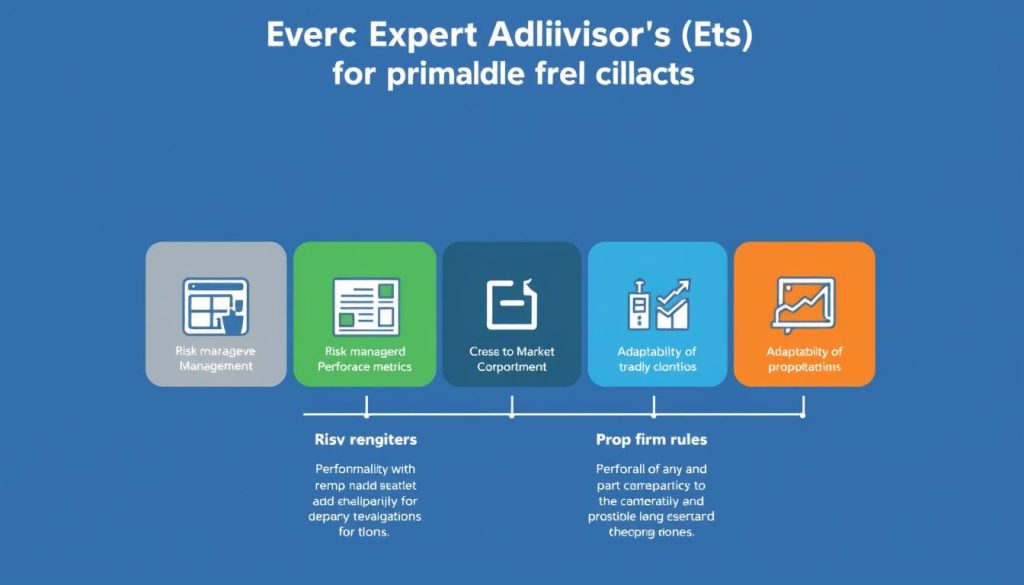Avoid EA Mistakes in Prop Firm Trading Evaluations
The world of automated trading is growing fast. Prop firms now use Expert Advisors (EAs) to check if traders are good enough. But, using EAs right in these evaluations is tricky. This guide will cover how to use EAs well in 2024, including strategies, rules, and how to make them work better.

Key Takeaways
- Learn how EAs play a big part in prop trading today and what makes them work well.
- Know the common mistakes EAs can make and the rules to follow in prop firm checks.
- Find out how to manage risks and test EAs before using them in evaluations.
- Discover the legal and technical steps needed for using EAs in prop trading.
- Get tips on keeping an eye on, tweaking, and fixing EA performance for lasting success.
Understanding EA Trading in Prop Firm Contexts
Expert Advisors (EAs) have changed the game for professional traders and prop firms in algorithmic trading. These automated systems, powered by advanced technology, have transformed how traders interact with the markets.
Defining Expert Advisors in Professional Trading
Expert Advisors, or EAs, are advanced software programs that make trades for traders. They follow set rules and algorithms. These tools are key in modern prop trading, allowing traders to automate strategies and seize market chances quickly and accurately.
Role of EAs in Modern Prop Trading
In the fast-paced world of prop trading, EAs are crucial for traders to improve their performance and stay ahead. They automate routine tasks, letting traders concentrate on analysis, risk management, and making strategic decisions. This ensures their trading plans are carried out reliably and consistently.
Key Components of Successful EA Implementation
- Robust algorithm design and backtesting
- Comprehensive risk management protocols
- Seamless integration with trading platforms
- Continuous monitoring and optimization
- Compliance with prop firm guidelines and regulations
Understanding how to use EAs effectively is key for prop traders aiming to succeed in the competitive prop trading world.
“EAs have become an indispensable tool in the arsenal of successful prop traders, enabling them to capitalize on market opportunities with unparalleled speed and precision.”
Common EA Trading Violations in Prop Firm Challenges
Trading with Expert Advisors (EAs) in prop firms is complex. Many trading rule violations, EA compliance issues, and misunderstandings of prop firm regulations can cause big problems.
One big mistake is changing EA settings without permission. Traders might adjust settings during challenges, not knowing it breaks rules. This can get them kicked out and hurt their reputation.
- Not following risk management rules is another big mistake. Prop firms need strict risk control. Traders who ignore this risk being kicked out.
- Not keeping good records of EA trades can also hurt a trader’s chances. Prop firms need clear records to check if rules are followed. Without these, traders can get disqualified.
Trying to use EAs in ways not allowed by the firm is also a problem. Prop firms set rules to keep things fair and honest. Breaking these rules can lead to serious penalties, like being banned forever.
“Successful prop trading with EAs requires a deep understanding of the firm’s regulations and a steadfast commitment to compliance. Ignoring these critical aspects can quickly derail a trader’s journey, regardless of their technical prowess.”
To succeed with EAs in prop firms, traders need to be very careful. They must know the trading rule violations, follow EA compliance rules, and understand prop firm regulations. This way, they can have a better chance of doing well.

Essential Rules for EA Usage in Prop Firm Evaluations
Automated trading in prop firms needs strict rules. Prop firms have rules for using Expert Advisors (EAs) to keep trading fair and compliant. Here are the key rules for traders using EAs in prop firm assessments.
Permitted EA Features
Prop firms let traders use EAs with certain features:
- Basic technical analysis indicators (e.g., moving averages, RSI, MACD)
- Simple trend-following strategies
- Risk management tools (e.g., stop-loss orders, position-sizing algorithms)
- Automated order execution capabilities
Restricted EA Functions
But, prop firms ban EAs with advanced features:
- Complex machine learning algorithms
- Automated decision-making processes that override human intervention
- Strategies that involve high-frequency trading or market manipulation
- Connections to external data sources or third-party services
Documentation Requirements
Prop firms also need detailed documentation from traders. This includes:
| Requirement | Description |
|---|---|
| EA Source Code | Traders must provide the complete source code of their EA, allowing prop firm analysts to review its functionality. |
| Backtesting Results | Traders must present comprehensive backtesting reports, demonstrating the EA’s historical performance and risk profile. |
| Operational Procedures | Traders must document the step-by-step process for setting up, deploying, and monitoring their EA in the prop firm’s trading environment. |
Following these rules helps traders meet EA trading rules, prop firm guidelines, and automated trading compliance needs. This increases their chances of success in prop firm evaluations.
Risk Management Protocols for EA Trading
Trading in a prop firm with automated systems needs strong risk management. It’s key to protect money and follow the firm’s rules. Let’s look at the main steps for automated risk management, EA trading safeguards, and prop firm risk controls.
First, prop firms must set clear position size limits for automated trading. This stops a single bad trade from ruining the whole account. They also need stop-loss mechanisms to limit losses and risk-to-reward ratios to guide the EA’s choices.
- Keep tight leverage and margin rules to avoid too much risk.
- Use strong monitoring and alert systems to catch and fix any problems fast.
- Always backtest and optimize the EA to make sure it works well and follows the firm’s rules.
Prop firms should also have clear escalation protocols for EA issues. This lets trading teams quickly solve any problems. Doing stress testing on the automated systems helps find and fix weak spots in prop firm risk controls.

“Effective risk management is the cornerstone of successful automated trading within a prop firm environment.”
By focusing on these EA trading safeguards, prop firms can create a safe space for innovation and profit. This approach lets traders use automation wisely, avoiding risks and ensuring growth for the long term.
How to Avoid Common Mistakes When Using an EA in Prop Firm Evaluations
Using an expert advisor (EA) in prop firm trading evaluations can be tricky. But, with the right steps, you can avoid common mistakes. It’s all about being well-prepared, keeping a close eye on your EA, and having a plan for emergencies.
Pre-evaluation Testing Strategies
Before you submit your EA for evaluation, test it thoroughly. This means:
- Backtesting to check its past performance
- Stress-testing to see how it handles market ups and downs
- Checking if it follows the prop firm’s rules and regulations
Performance Monitoring Tools
While your EA is being evaluated, keep a close watch on its performance. Use EA optimization tools to track important metrics. This includes trading evaluation preparation and automated trading safety. This way, you can spot any issues quickly.
| Metric | Importance |
|---|---|
| Win Rate | Shows if the EA makes profitable trades |
| Drawdown | Tells you about the EA’s risk management |
| Sharpe Ratio | Checks the EA’s performance after adjusting for risk |
Emergency Shutdown Procedures
Make a detailed automated trading safety plan for emergencies. Make sure you can stop the EA quickly and safely. This helps prevent big losses.
“Proper preparation and vigilance are the keys to successful EA deployment in prop firm evaluations.”
By following these steps, you can steer clear of common EA mistakes. This will help you succeed in prop firm trading evaluations.
Selecting Compatible EAs for Prop Firm Requirements
Choosing the right Expert Advisors (EAs) for prop trading is key. They must meet the prop firm’s specific needs and goals. The EA’s fit with the firm’s trading platform, risk management, and strategy is crucial for success.
Prop traders should look at these factors when picking an EA:
- EA selection criteria: Check the EA’s performance, reliability, and flexibility. It should fit the firm’s trading rules and risk management. Look for EAs with a good track record and the ability to follow the firm’s guidelines.
- Prop trading software compatibility: Make sure the EA works well with the firm’s trading platform. It should smoothly integrate with the current trading setup. Verify it can handle trades, monitor markets, and analyze data in real-time.
- Compatible trading algorithms: Evaluate the EA’s algorithms to see if they match the firm’s strategies and risk level. Choose EAs that trade accurately, reduce slippage, and make consistent profits within the firm’s risk limits.
By picking the right EAs, prop traders can boost their chances of success. They show they can handle the challenges of professional trading.

“Selecting the right EA is not just about finding the one with the highest win rate; it’s about finding the one that fits seamlessly with the prop firm’s trading ecosystem.”
Optimizing EA Parameters for Challenge Success
As professional traders, optimizing your Expert Advisor (EA) parameters is key to success. The secret to top algorithmic trading performance is a solid backtesting, parameter tweaking, and performance analysis process.
Backtesting Requirements
Backtesting is the base of any good EA optimization plan. Traders need to carefully check historical market data. They should test their EAs under different market conditions to find the best settings.
This detailed method makes sure the EA works well and boosts the chance of doing well in live prop firm challenges.
Parameter Adjustment Guidelines
- Find the main parameters that affect your EA’s performance, like entry/exit rules and risk settings.
- Change these parameters one by one, watching how the EA reacts and finding the best settings.
- Use stats and performance metrics to check if your tweaks improve the EA’s EA optimization, algorithmic trading performance, and prop challenge success.
Performance Metrics Analysis
It’s crucial to analyze various performance metrics for EA optimization. Traders should look at win rate, risk-adjusted returns, drawdown, and profit factor. This helps understand the EA’s good and bad points.
This data-driven method helps make smart choices and fine-tune the EA. It ensures the EA is ready to do well in prop firm trading challenges.
| Performance Metric | Description | Optimal Range |
|---|---|---|
| Win Rate | Percentage of successful trades | 60% – 80% |
| Risk-Adjusted Returns | Measure of returns relative to risk | 1.5 – 3.0 |
| Drawdown | Maximum observed decline in account value | |
| Profit Factor | Ratio of total profits to total losses | > 1.5 |
By following these EA optimization best practices, traders can fully use their trading strategies. This leads to success in prop firm challenges and reaching their prop challenge success.

Legal Considerations in EA-Based Prop Trading
Expert Advisors (EAs) are becoming more popular in prop trading. It’s important for traders to understand the legal side of things. They need to know about automated trading rules, prop firm compliance, and EA laws.
Prop firms must follow the latest automated trading regulations to stay out of trouble. They need to know the rules from bodies like the SEC and FINRA. Following these rules shows they are fair and open in their trading.
For prop firm legal compliance, it’s key to have the right policies and procedures. Firms need to make sure their rules match the laws. This includes having good risk management, keeping trading records, and teaching traders about EA laws.
- Know the EA trading laws in your area to trade legally.
- Get advice from lawyers to keep up with new rules and how they affect your trading.
- Make detailed plans about your firm’s policies and how you follow EA laws.
By focusing on the legal side of EA-based prop trading, traders can trade with confidence. They can make sure their trading is legal and can keep going for a long time.

| Legal Aspect | Key Considerations | Potential Consequences |
|---|---|---|
| Automated Trading Regulations | Adherence to SEC and FINRA guidelines, risk management protocols, trading record maintenance | Fines, legal penalties, loss of trading privileges |
| Prop Firm Legal Compliance | Internal policy alignment, trader education, detailed documentation | Reputational damage, legal disputes, trading suspensions |
| EA Trading Laws | Jurisdictional regulations, legal consultations, comprehensive documentation | Regulatory violations, legal liabilities, trading restrictions |
After avoiding this mistakes, learn how to monitor and evaluate your eas performance during a prop firm evaluation.
“Navigating the legal landscape in EA-based prop trading is essential for long-term success. Compliance and transparency are key to building a sustainable trading strategy.”
Technical Setup for Reliable EA Performance
Creating a strong trading setup is key for your Expert Advisor (EA) to work well. In prop trading, how you set up your EA environment is very important. You need to plan and set up your Virtual Private Server (VPS), keep your network stable, and have backup systems in place.
VPS Configuration Best Practices
Choosing the right VPS is very important for your EA trading setup. Look for a VPS provider that offers high uptime, low latency, and strong hardware. Make sure your VPS can handle your trading strategies well, with enough power, memory, and storage.
Network Stability Requirements
Having a stable and reliable network is crucial for prop trading with EAs. Get a fast and reliable internet connection with little downtime. Use multiple internet providers or failover systems to avoid network problems. Keep an eye on your network and fix issues quickly to keep your VPS running smoothly.
Backup Systems Implementation
It’s important to protect your trading data and EA settings. Set up good backup systems to keep your important information safe. Back up your EA settings, trading history, and other key files regularly. Use cloud storage or local backups to keep your EA setup safe.

“Reliable technical infrastructure is the foundation for successful EA-based prop trading. Investing in the right VPS, maintaining network stability, and implementing robust backup systems can make all the difference in maximizing the performance and longevity of your trading strategies.”
Monitoring and Adjusting EA Performance
Keeping a close eye on your EA performance tracking is key during prop firm checks. By watching your expert advisor’s (EA) trades, you can spot ways to improve. This helps you make quick changes to keep your algorithmic trading optimization on track. It’s vital for steady results and showing the strength of your prop trading analysis plan.
To track EA performance well, use advanced analytics tools. They give you live insights into how your trading system works. These tools help spot trends, oddities, and market changes fast. By checking important metrics like win/loss ratios and profit factors, you can tweak your EA to keep it winning.
- Set up detailed EA performance tracking systems to gather and study all trading data.
- Keep up with and study trading outcomes to find ways to get better.
- Use smart algorithmic trading optimization methods, like machine learning, to boost your EA’s choices.
- Be ready for any prop trading analysis problems or market changes that might need EA tweaks.
By actively watching and tweaking your EA’s performance, you show you can adjust to market changes. This skill is crucial for keeping profits up during prop firm reviews. Your hard work and quick responses will make you stand out and boost your success in prop trading.

Common EA Technical Glitches and Solutions
Working with expert advisors (EAs) in prop trading can be tricky. Technical problems often pop up. Knowing how to fix these issues is key to keeping your trading strategies on track.
Troubleshooting Framework
When you run into EA troubleshooting issues, it’s important to have a plan. This plan should help you find and fix the problems. Here’s what to do:
- Start by looking closely at algorithmic trading errors. Check for things like connection problems, data issues, or coding mistakes.
- Use prop trading technical support to narrow down the problem. Try running the EA in a test mode or check system logs for errors.
- Work with the EA provider or your team to fix the issue. This way, you can solve the problem quickly and well.
Emergency Response Protocols
When a big EA troubleshooting problem happens, you need a plan. This plan should help you act fast and protect your trading. Here’s what to do:
- Stop the EA from trading right away to avoid losing money.
- Write down the problem and how you’re solving it.
- Tell everyone who needs to know, like the risk team.
- Switch to a backup system or trade by hand if needed.
Having a solid troubleshooting framework and emergency response protocols helps prop trading firms deal with algorithmic trading errors. This way, they can keep their EA-based trading strategies working well.
Building a Sustainable EA Trading Strategy
Successful long-term EA trading in a prop firm needs a solid strategy. It’s not just about passing initial tests. It’s about creating a plan that works well over time.
To make a great EA trading strategy, prop traders must know what makes it last. This includes:
- Keeping a strong risk management plan
- Adjusting EA settings for changing markets
- Monitoring and tweaking performance regularly
- Having reliable tech and backup systems
- Following all rules and keeping records
By focusing on these key points, prop firms can create EA trading strategies that last. These strategies bring in steady profits and keep them ahead in the fast-paced world of algorithmic trading.
“Sustainable EA trading is not just about winning initial challenges; it’s about building a resilient, adaptable system that can thrive in the long run.”
Prop firms that work on a strong, all-around EA trading strategy can handle market changes well. They use automation wisely, keeping a close eye on risks and rules.
By following the keys to long-term EA trading success, prop firms can reach the full potential of algorithmic trading. This ensures their strategies stay effective, profitable, and lasting for years.
Documentation and Compliance Requirements
In the world of professional trading, keeping detailed records and following rules is key. For those using Expert Advisors (EAs), it’s important to keep accurate records and have a solid audit trail. This is crucial for success.
Record Keeping Best Practices
Prop firms need a detailed record of every EA trade. This includes logs of EA settings, strategy changes, and how well the EA performed. Keeping these records helps traders follow prop firm rules and answer any questions quickly.
Audit Trail Maintenance
Prop firms also want a clear audit trail to check EA trading activities. This means keeping records of all EA trades, system logs, and other important data. A strong audit trail helps traders show they follow rules and are transparent in their trading.
FAQ
What is the role of Expert Advisors (EAs) in modern prop trading?
EAs are key in modern prop trading. They automate trading strategies. This lets traders use advanced algorithms for faster, more consistent decisions.
What are the key components of successful EA implementation in prop firm contexts?
For EAs to work well in prop firms, several things are important. These include good risk management, clear documentation, following firm rules, and keeping an eye on performance.
What are some common EA trading violations that prop firms aim to prevent?
Prop firms try to stop violations like using banned EA features and not following trading rules. It’s important to follow firm guidelines to avoid these problems.
What are the permitted and restricted EA features in prop firm evaluations?
Prop firms have rules for EA use. They allow things like automated orders and risk tools. But, they don’t allow things like making decisions on your own or using outside signals.
How can traders ensure effective risk management when using EAs in prop firm evaluations?
To manage risk with EAs, traders need to set limits and diversify. They should also keep an eye on the EA’s performance and adjust it as needed.
What are the key steps to avoid common mistakes when using an EA in prop firm evaluations?
To avoid mistakes, traders should test EAs well before using them. They should also use tools to monitor performance and have a plan for emergencies.
How can traders select compatible EAs that meet prop firm requirements?
Choosing the right EA means checking if it fits the firm’s goals and risk level. Traders should look at the EA’s features, test results, and how well it matches the firm’s expectations.
What are the key considerations for optimizing EA parameters to maximize prop trading challenge success?
To get the most out of EAs, traders need to test them well and adjust settings carefully. They should also understand what the firm looks for in performance.
What are the legal considerations and regulatory requirements surrounding the use of EAs in prop trading?
Traders must follow laws and firm rules when using EAs. This includes keeping records and following rules on automated trading.
What are the technical setup best practices for ensuring reliable EA performance in prop firm evaluations?
For EAs to work well, traders need a strong setup. This includes a fast VPS, stable internet, and backup systems to avoid technical issues.
How can traders effectively monitor and adjust EA performance during prop firm evaluations?
Traders should keep an eye on key metrics like profits and losses. They should also adjust the EA as needed to keep up with market changes.
What are the most common EA technical glitches and how can traders troubleshoot them?
EAs can have problems like data issues and crashes. Traders should have a plan to fix these quickly to keep trading smooth.
How can traders build a sustainable EA trading strategy for long-term success in prop firm environments?
A lasting EA strategy needs to adapt to markets and manage risk well. It should also be able to meet firm rules over time.
What are the key documentation and compliance requirements for EA trading in prop firm evaluations?
Keeping detailed records is key for EA trading in prop firms. Traders must follow the firm’s record-keeping rules and be ready for audits.
Struggling with your challenge? Our prop firm ea ensures success.
